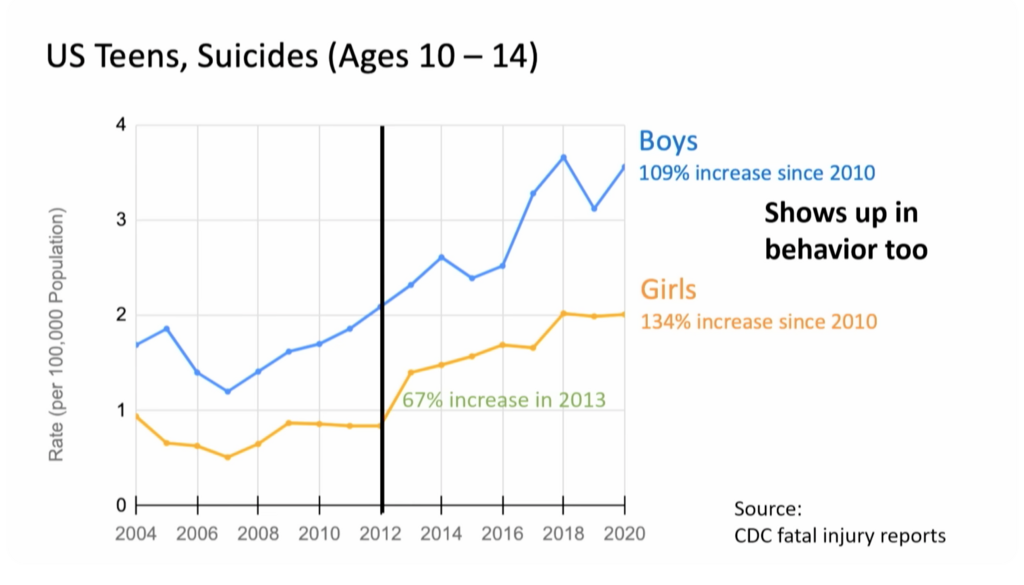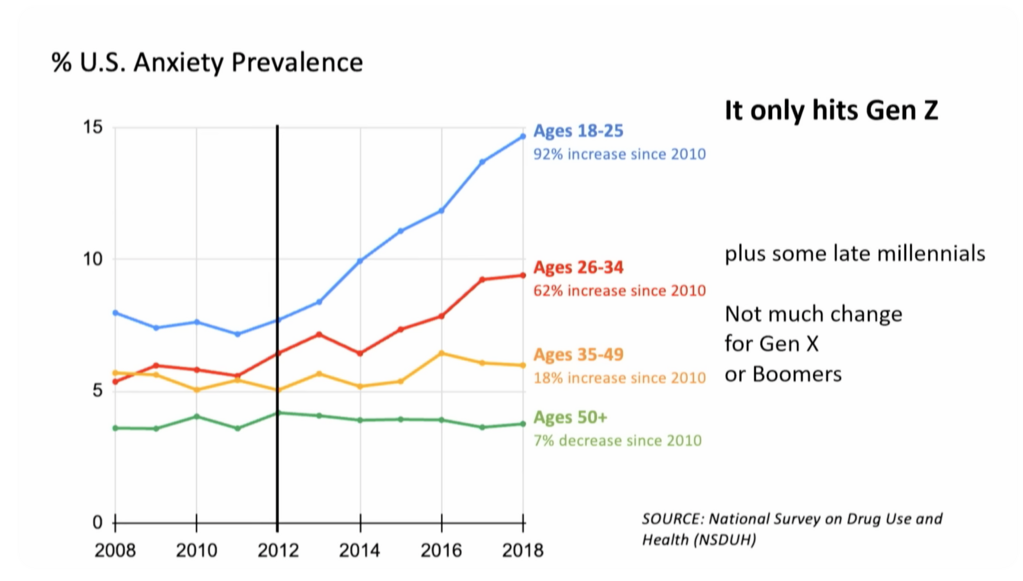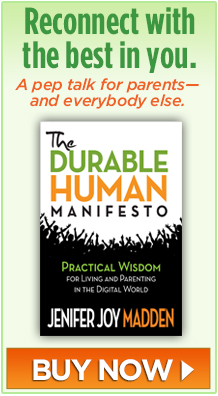
“Technology is just not adding value in the classroom.”
Heads nodded among the teachers who filled our audience at SXSW EDU 2024.
At the Austin, Texas conference—where sessions seemed All About A.I.—our talk, “Log-off and Learn: Healing the Broken Classroom”, stood apart.
My co-presenter, award-winning child advocate Lisa Cline, quoted the 2023 UNESCO report, Technology in Education: a Tool on Whose Terms: “There is little robust evidence on digital technology’s added value in education.”
And this: “A lot of the evidence comes from those trying to sell it.”
Despite the billions in federal money that flowed to U.S. schools to support remote learning during COVID, Lisa had the sad reality check: “Math and reading skills are at their lowest in decades.”
Even before the pandemic, as smartphones proliferated among children, their academic, mental, and physical health began a decline—dragging down their ability to be happy and content.
That is why, Lisa and I believe, students have become less available for learning.
The Real Ed-tech Story
Lisa defines ed-tech as “The Chromebooks, the iPads. It’s the hardware and it’s the software. It’s Naviance, Pear Deck, Flipgrid, of course Google. And these are all very much for-profit companies.”
Collectively, Lisa continues, “they make $340 billion a year here in the U.S.”
She ticks off reasons why wholesale adoption of ed-tech can be a losing proposition.
For starters, it’s hard for kids to learn the basics on a computer, as when learning how to read and write: “They struggle with memorization much more than kids that learn with tactile pencil and paper.”
Reading on a screen can result in less “reading stamina,” Lisa reports. “That’s the ability to sit for a sustained period of time and really focus on what you’re doing and read.”
A 2023 EdWeek teacher survey shows that half believe the reading stamina of students in grades three to eight has dropped precipitously since 2019.
As we adults do, students tend to skim what they read on a screen. “If you are reading with a book and you can highlight and annotate and dog-ear your pages, you’re getting deeper learning,” Lisa points out.
Yet, books continue to disappear from the classroom and ed-tech piles on.
Before COVID, school districts had an average of 548 digital tools at their disposal. Now it’s over 1, 400.
But Does Ed-tech Work?
With so many ed-tech products in use, Lisa asks and answers her own question: which result in better learning?
“Well, we really can’t know because there are no standards of effectiveness right now—no measurement tools that are not peer-reviewed and independent.”
Just the day before, Lisa and I attended another SXSW session where a European venture capitalist admitted ed-tech products are typically valued on levels of engagement (how long a student uses a product) rather than effectiveness (whether the product improves learning).
Meanwhile, online communication between schools and students can be overwhelming.
Before our event, Lisa checked in with Joe Clement, a Virginia high school teacher and co-author of Screen Schooled: Two Veteran Teachers Expose How Technology Use is Making Our Kids Dumber.”
Joe says he’s never seen students so confused about class details like due dates of assignments and tests. “They say they get so many notifications and reminders that they just turn them off. They become numb to them.”
Lisa and I met each other and Joe through the Screen Time Action Network, an arm of the child advocacy group FairplayforKids.org.
Lisa is a champion for the 160,000 public school students of Montgomery County, Maryland. She led efforts to protect their data and filter out harmful content on school-issued Chromebooks. She also wrote school guidelines for screen time and cellphone use.
The Mobile Elephant in the Room
“And then there are the cellphones,” Lisa says with a sigh.
“We know that cellphones tank grades. It’s really hard to focus if there’s a cellphone next to you or on you.”
Besides stealing students’ attention, cellphones can steal their friendships and even their food, as they go heads down to catch up during breaks.
“I have heard from parents,” reports Lisa. “Their kids don’t eat lunch because they go to lunch and they’re like, they have their face on the phone and they’re starving when they get home.”
Policing phones is also a problem.
A science teacher in Lisa’s school district did the math.
In an average week, he spends an average 45 minutes dealing with students’ cellphones. Over a school year, that’s six weeks of lost instruction.
Lisa notes that 75% of U.S. schools do have policies limiting phone use to academic purposes. “The bad news is that ‘academic purposes’ are everything from doing a Kahoot or quizlet in class, to looking at a Khan Academy video.”
After all that has transpired, many kids are actually fed up with ed-tech, as Lisa told the crowd.
“They say they cringe when the teacher says, ‘Get out your Chromebook’. They like books. You give them the option of a paper packet or doing it online, a lot of them will take the paper.”
The Waning State of Student Well-being
Then it was my turn.
I told the audience my part should be called, ‘The Tale of Too Many Hockey Sticks.’
Trend lines in children’s physical and mental health had been fairly stable for years. Then they turned starkly upward or downward—just like hockey sticks.
The shifts occurred between 2010 and 2015—the span when smartphones and social media became ubiquitous among young people.
From the human perspective, we can understand why mobile digital devices have had unexpected effects on us. We didn’t evolve with them, nor were they ever designed for children.
Kids’ Durability Under Siege
Durability is different from Resilience, a word we heard a lot in the pandemic.
Resilience is the ability to bounce back after being knocked down by adversity. To be Durable is to stay upright and balanced as you navigate life’s bumps in the road.
“Durable” is the alternative to Jonathan Haidt’s more awkward “antifragile,” a word the NYU social psychologist uses often in his talks and new book, The Anxious Generation: How the Great Rewiring of Childhood is Causing an Epidemic of Mental Illness.”
Kids have become less durable in many ways.
Their Physical Health is Hurting
For one thing, children and teens have more trouble maintaining a healthy weight and getting enough exercise. Their role models, of course, spend plenty of time sitting and staring at screens.
In the 1960s, one in twenty kids was overweight. Now it’s one in five. That means many more of them are physiologically teed up for chronic diseases.
Kids’ eyesight is worse. An epidemic of myopia is sweeping the world’s children.
Otherwise known as near-sightedness, myopia is aided and abetted by staring at screens, coupled with little time spent outdoors in the sunshine. The condition permanently degrades children’s vision.
The fact that half of all humans may soon wear glasses may not seem like a big deal until you consider 1 in 3 people with severe myopia will eventually become visually impaired or even blind.
Students’ sleep has taken a hit, which is a profoundly big deal.
The National Sleep Foundation reports that 6 out of 10 middle schoolers and 7 out of 10 high schoolers do not get enough sleep on weeknights.
Lack of sleep causes a host of physical ailments, from weight gain to being more susceptible to illness, which leads to absenteeism and poorer grades.
Sleep is also crucial to the learning process by allowing the brain to transfer information taken in during the day into long-term memory.
A child whose sleep is disrupted or shortened can’t go through that saving process. When they need the information for a test, it simply may not be there.
Mental Health is Suffering, Too
Kids, particularly in early primary school, are having trouble sitting down and paying attention.
ADHD rates are up 50% in the past 10 years. That’s at least partly due to hyper-stimulation of the nervous system caused by interaction with screens.
Whether used in or out of class, their phones and attendant social media apps can pull students into very dark places. Bullying and porn are just two possibilities.
Social media is at least partly to blame for the plummeting mental health of young people, the U.S. Surgeon General asserts.
Over 10 short years, 40% more high school students have fallen into persistent feelings of sadness or hopelessness.
Despite their being hyper-connectedness online, there is worldwide increase in how many adolescents feel lonely.
Two of the more horrible hockey sticks are illustrated by slides developed by Jonathan Haidt.
Between 2012 and 2020, suicides rose 109% among boys and 134% among girls. Their ages? 10 to 14.

Anxiety levels soared during the same period.

Luckily, 90% of US schools have more staff to help students with social-emotional issues. For many schools, though, support may end with the end of federal COVID funding.
After asking everyone to stand up and stretch, we turned to the brighter side.
10 Ways Teachers Can Heal the Broken Classroom and Help Students to Be More Available for Learning
Lisa gave the first five Solutions:
Get rid of the phones. If not left at home, store them during the school day, or at least during class. “Shoe organizers, cellphone cubbies, these are all really good.” (Suggest to parents they check out the newly formed Phone Free Schools Movement.)
Vet ed-tech products. “Talk to your administrators and say, ‘before you’re asking me to use Flipgrid or Pear Deck or whatever it is, show me that it works. Show me that it does something better than I can do’,” Lisa suggests. Also: when using an ed-tech product, set performance goals then track results.
Offer offline alternatives to tech. “You’ll be really surprised at how many kids take it and how many families want it on paper,” says Lisa. As always, tangible paper notebooks and assignment books help students stay organized.
Beware of AI. “Integration of AI can degrade teacher-student relationships, corrupt curriculum with misinformation, encourage student performance bias, and lock schools into a system of expensive corporate technology,” says a new National Education Policy Center analysis. Irrespective of the advisability of AI as a teaching tool, establish the student’s foundations of learning first, Lisa advises. “So that’s reading, writing, basic math, and the fine art of learning to think and to solve problems.”
Read, read, read, and read. Reading for school and for pleasure leads to better grades, a better chance of getting into college, and better mental health. “Encourage them to go to the media center, get a library card,” encourages Lisa. “They’ll roll their eyes, but it makes a significant impact on their ability to do life and do school.”
I gave the final 5 teacher tips:
Eliminate midnight deadlines. Students need sleep. Even if midnight is the default in the software, override it and enter an earlier deadline. You will have a direct impact on your students’ health.
Teach (and follow) the 20-20-20 Rule. To help maintain versatile vision and avoid eyestrain and an aching forehead, The American Optometric Association recommends everyone to look up and away from the screen every 20 minutes at something at least 20 feet away for 20 seconds. I can tell you from experience it works.
Get up and move at least every hour. Simply standing up boosts kids’ physical health by keeping them more active. Moving also serves as a brain break to help them focus. The human brain develops a mental logjam after about an hour or two of ingesting information. A brief break refreshes students so they’re ready to resume learning.
Teach mind management. Kids need to know how to manage their emotions and direct their attention. Even little ones can learn self-calming techniques like Sharkfin. With Inner Explorer all you do is press Play. The online platform serves up daily 5- to 10-minute pre-recorded audio mindfulness lessons tailored to students Pre-K through high school. IE has been shown to improve student coping skills, academic performance, and classroom behavior, plus lower teacher stress.
Be you. Most of all, students need teachers. The UNESCO report concludes: “tech in education should only be used to enhance learning and support student well-being,” but “never to replace in-person teacher-led instruction.” I hoped our audience would dwell in that reality: “Feel really good about that inside,” I said. “Listen as you say to yourself: ‘They need me.’”
The Sweet Spot: Minimal and Meaningful
After studying all this for quite a while—and taking the journey into the digital age along with my own three children—I believe there is a balance point where kids can be durable even as they interact with technology.
That is, when their tech use is minimal and meaningful.
Minimal happens automatically when kids do all those non-screen skill-building activities they need to become self-sufficient, skilled grownups. Think: chores, sports, unplugged free play, alone time, family time, and enough sleep.
Meaningful means that their tech use is emotionally supportive in some way. Sure, it would be great if they actually learned something playing a video game or being on social media, but at least if they feel intact—and not devastated, desperate, hopeless, or morose—when they stop.
A student who finds that balance will have the best overall health, and therefore be the most available to learn.
About the author: Jenifer Joy Madden is a certified digital wellness educator, health journalist, and author of The Durable Human Manifesto: Practical Wisdom for Living and Parenting in the Digital World and How to Be a Durable Human: Revive and Thrive in the Digital Age Through the Power of Self-Design. She founded DurableHuman.com in 2009, not long after Steve Jobs introduced the iPhone.





Thank you for bringing these vital points to the forefront for educators and administrators. So many school districts buy into Ed Tech because it’s cheaper than text books or is popular with the students…but like you have said in this article…”Where is the data that supports the learning.” Limiting them can be hard to challenge as a teacher in my experience when districts buy into these programs and expect teachers to spend a certain amount of time using them each day as district mandates. If the data is not showing their learning is improving…why do we keep using them? In my opinion many of these mandated apps are actually time wasted that the students could be learning…instead of guessing and not taking the time to understand why the problem was correct or incorrect. Little interaction = little learning!